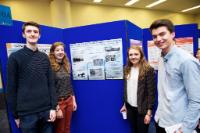2016 Participants
 James Linighan & Team
James Linighan & Team
This expedition provided the team with the opportunity to collect primary field data from a dynamic glaciated landscape which is clearly responding to climate change. Our research will help to build a clearer understanding of the response of our study glaciers to atmospheric and oceanic temperature changes. The guidance and logistical support provided by members of the University Centre in Svalbard was invaluable to our research and allowed us to conduct fieldwork safely and efficiently. Below is an overview of the research conducted at each glacier.
Three separate projects were carried out on Longyearbreen Glacier. Kirstie Murphy investigated how variations in the thickness of debris cover on the surface of the glacier influenced the rate of summer ablation. The results show clear disparities in melt relating to the amount of debris present on the surface. The effects of temperature and localized weather conditions on glacial ablation were studied by Rebecca Burley, with preliminary findings showing that temperature mainly varies with direction of wind and shading from topographical influences. Emily Potter examined the short term evolution of three supraglacial meltwater channels on the glacier, taking twice daily discharge measurements along the long profile of the streams.
Research at Tunabreen was conducted by James Linighan alongside Associate Professor Chris Borstad from the University centre in Svalbard. On three separate days we travelled 15 km by boat to reach Tunabreen, a marine terminating glacier flowing into Tempelfjorden. Research was undertaken into the location of moulins on the glacier surface to examine the glacial processes which lead to their creation.
At Scott Turnerbreen Glacier, Jack Oxtoby carried out his research into the change in the glaciers mass balance over the last 20 years. High accuracy dGPS points taken over two field days can be combined with a previous dataset to create a DEM of difference inferring mass balance change since 1996. Hannah Davies examined the weathering processes taking place on the moraines of both Rieperbreen and Longyearbreen glaciers. Overall there was a variation in weathering and erosion at both Longyearbreen and Rieperbreen, which indicates complex processes are taking place on these moraines.
Funding sources: Newcastle University Expeditions Committee, The Gino Watkins Memorial Fund, The Royal Geographical Society Fieldwork Grant and The Andrew Croft Memorial Fund
Project Supervisors: Dr Rachel Carr, Dr Andy Russell and Dr Neil Ross
